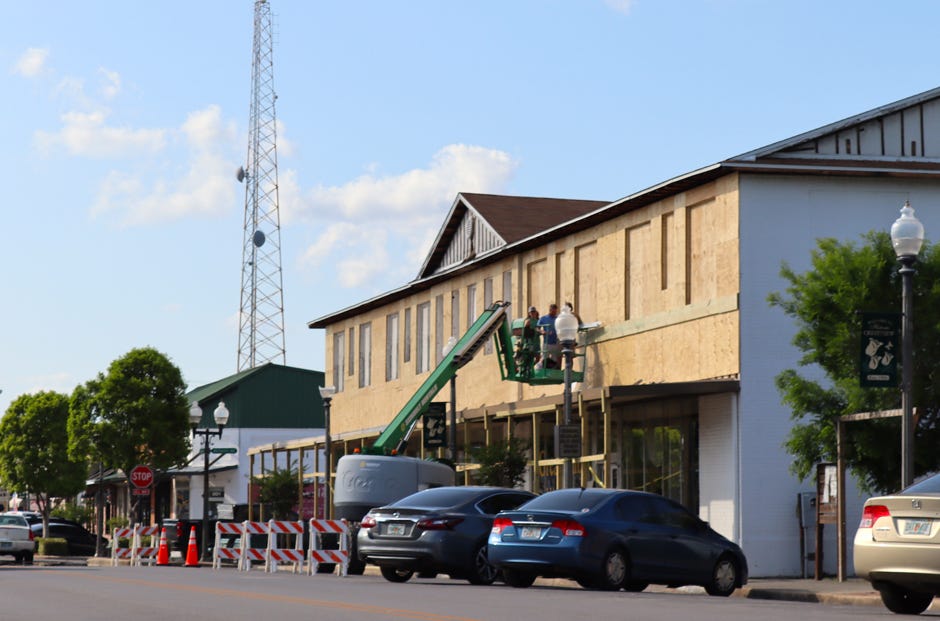CRESTVIEW — For longer than there’s been a Crestview, there’s been a hotel on Main Street spanning the block between Woodruff Avenue and the alley to the south.
Now the 1926 Lamar Hotel (later the Hilton Hotel), more familiar today as the home of Desi’s Family Restaurant, is getting a welcomed facelift.


Like all of Crestview’s downtown hotels, the first building on the lot, the Powell Hotel, which probably opened in the late 1880s, originally welcomed guests arriving or departing aboard the daily trains that serviced the community.
Its proprietor, Hamner F. “Doc” Powell, considered Crestview’s first citizen, had the contract to supply lightwood for the Pensacola and Atlantic Railroad’s locomotives stopping at “Crestview Station.”

He soon became Crestview’s first railroad agent, first home builder, first postmaster, and upon opening his hotel, the town’s first merchant.
His Powell Hotel, the town’s first business, was a handsome two-story wooden framed building with a nice balcony overlooking Main Street. It’s listed in the 1886-87 Florida State Gazetteer and Business Directory, and also was a rooming house.
Doc’s wife, Eunice, managed the hotel after they married in 1901. Across the street was his livery stable, next to which he built a restaurant. Like his hotel, it catered primarily to P&A Railroad passengers.
There would be later hotels, including the Crescent Hotel, built across the tracks in the late 1900s (roughly where the State Road 85 overpass is today); and the 1915 Okaloosa Hotel, on the east side of Pearl Street on the corner of Railroad Avenue.


But the Lamar Hotel, opened in June 1926, would prove the city’s most enduring, and for 11 years, the city’s largest building until the Smith-Johnson Shirt Co. opened — now known as the Alatex Building, home of the FAMU pharmacy school.
Built of brick by contractor Johnny Wilkinson for W.H. Graham on the site previously occupied by the Powell Hotel, the grand, two-story block-long landmark had 46 rooms upstairs. It cleverly used a central lightwell down the center to assure every room had natural sunlight.
A canopy and balcony protected pedestrians walking the length of the hotel along Main Street.
According to the Dec. 10, 1925, Okaloosa News-Journal (forerunner of today’s Crestview News Bulletin), “The lower floor will constitute five store rooms, one will be used for a lobby, one for a café and the other will be used for stores.”
One of those first ground-floor stores was the Cox Hardware Co. on the hotel’s Main and Woodruff corner. After Cox Hardware moved up Main Street, Scarborough Auto and Home Supply took over the corner, with Roystan’s B.F. Goodrich tire sales shop. A large second-floor lobby spanned much of the building’s depth.
By the time of its sale to Aubrey and Rosa Nell Hilton about 1940, the hotel badly needed refurbishment. The Hiltons removed the front balcony and canopy, putting decorative awnings over the Main Street hotel lobby and store entrances. Each room received a private bathroom.
The Grill restaurant opened next to the central downstairs lobby in the space currently occupied by Great Faith Ministries. It was run by Marie Douglass, whose husband, W.D. “Cooter” Douglass, was the local radio personality who famously nicknamed County Road 2 south of Laurel Hill the “Hog and Hominy” for its rural setting.
The commercial space on the corner of Main Street and the alley was home to the B.S. Gillman Furniture Co., a local Kelvinator appliance dealer.
Today, the site of the former B.F. Goodrich store on the corner of Woodruff and Main, and the former hotel lobby, comprise Desi’s Restaurant.
Many a World War II Eglin Field soldier and airman was grateful for that large second-floor lobby. If they missed the last bus back to base following a night’s carousing in Crestview — the place to go on a weekend pass — Aubrey Hilton would rent them a cot in the lobby.


That spacious upstairs lobby still spans most of the building, with hallways branching off to each wing. While dividing walls between the rooms have been largely removed, bright colors on the rooms’ exterior walls and unpainted strips in the ceiling show where each of the 46 rooms stood. Two of the southeast corner rooms remain intact, giving an idea of how cozy the accommodations were.
As exterior renovations continue, passers-by can again see the rows of windows marking the 10 rooms facing Main Street, most separated by the smaller bathroom windows. The canopy that sheltered 1920s and ’30s pedestrians from afternoon downpours is being restored.
While the ugly vinyl siding that once shrouded the second floor has been removed, the windows themselves, though defined, will remain blocked since the second floor is unused. Perhaps one day a major renovation will occur, bringing that large upstairs space up to modern building codes. Lovers of old buildings and Crestview history can only hope.
But for now, while Desi’s hungry weekday lunch crowd feasts on the city’s best fried chicken down below, the vast, block-long upper floor remains unoccupied, except, perhaps, for the spirits of a few of the thousands of railway travelers and Eglin Field soldiers who found shelter in W.H. Graham’s downtown landmark.
Sources for this article include "Crestview: The Forkland," by Betty Curenton and Claudia Patten; and the Baker Block Museum. Special thanks to Lois English for the look-see upstairs.
This article originally appeared on Crestview News Bulletin: Checking in at Crestview’s Lamar Hotel
